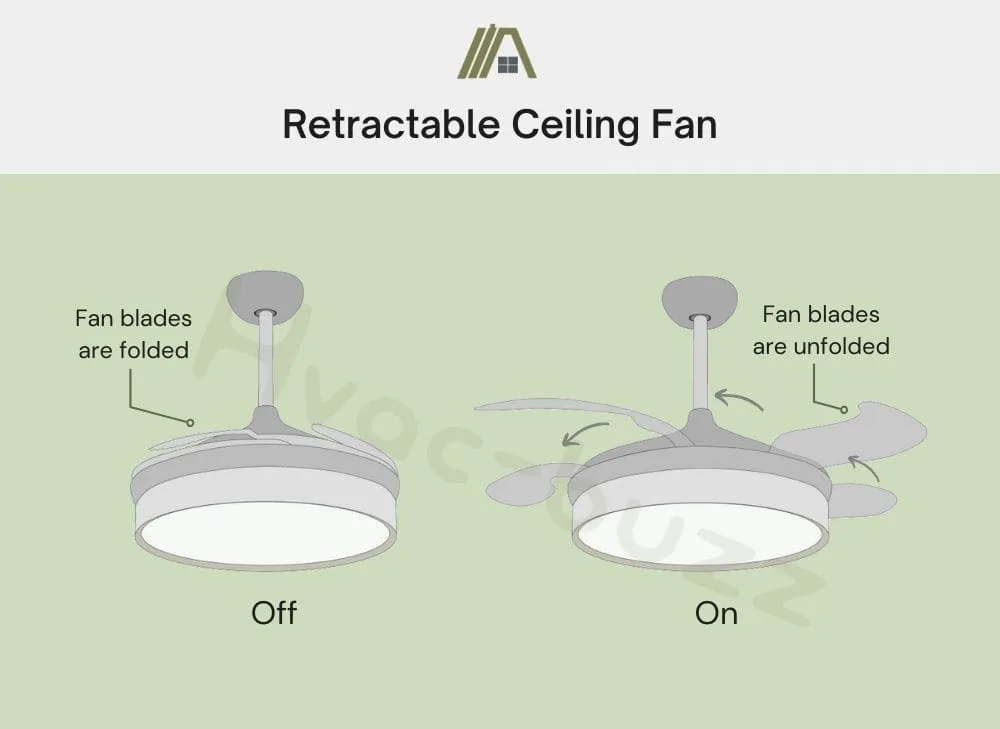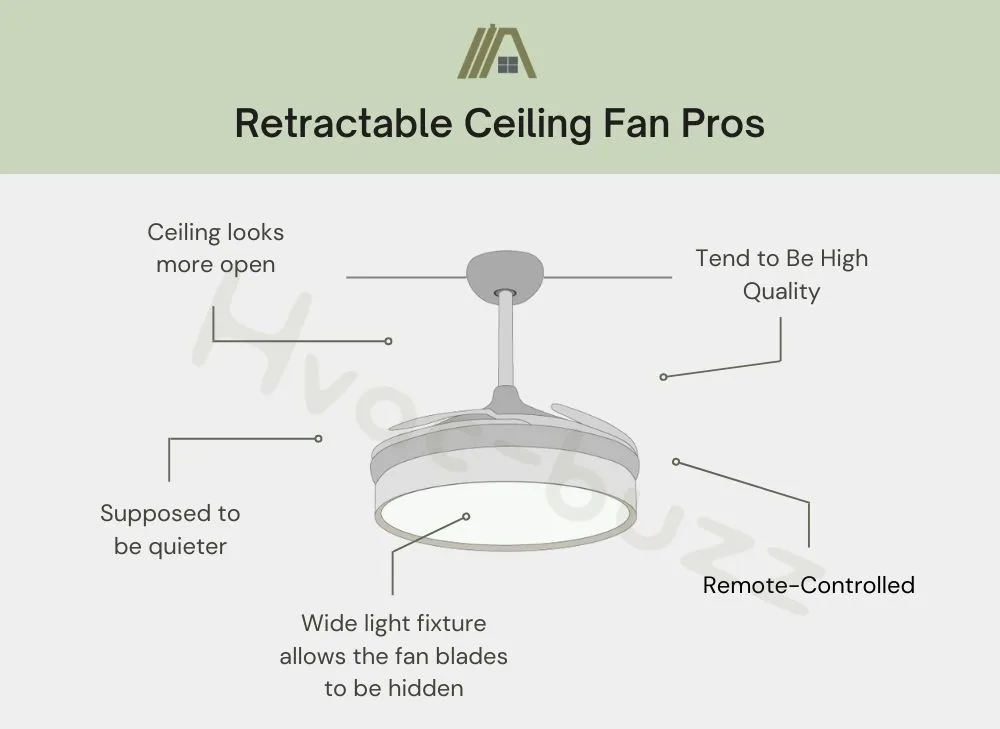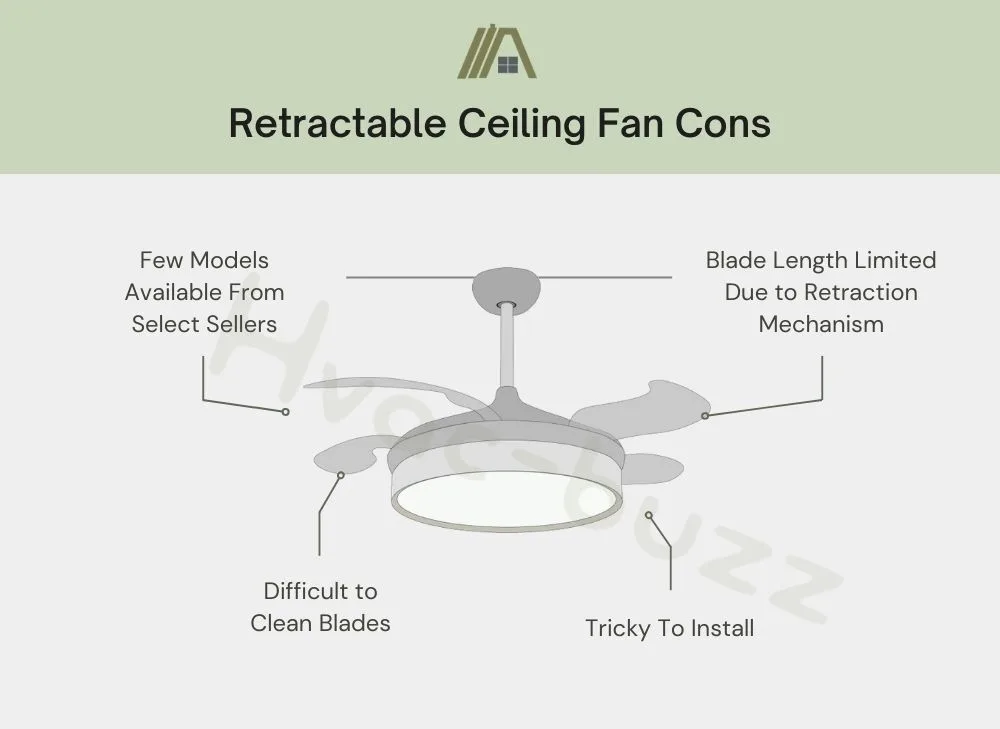
Retractable ceiling fans suit clean aesthetics and create an open-ceiling look, but style choices are limited. They are high-quality due to the design, but it also makes installation trickier and clean. They are quiet and remote-controlled, but airflow may be limited due to flush-mounting and shorter blades.
| Pros | Cons |
| Blades hidden and low-profile when not in use | Few models available, limiting choice in style |
| Blades barely visible even in use so room looks “open” | Difficult to clean due to overlapping of the blades |
| Typically high quality as the retraction mechanism requires good materials | Blades must be short to retract, limiting possible airflow |
| Generally quieter than traditional fans due to light weight and quality motor | Tricky to assemble and requires flush mounting |
| Often remote-controlled, allowing convenience |
Retractable Ceiling Fans Pros
Some People Don’t Like the Bladed Look
Let’s face it, ceiling fans take up a lot of visual space. Many people try to mitigate this by going for sleek, minimal, flush-mount or hugger ceiling fans to help a room look larger and more open.
However, sometimes that isn’t enough. For some people, just having any sort of bladed fan doesn’t fit their desired aesthetic.
Retractable fans generally feature flat, wide light fixtures that allow the fan blades to hide more easily. On top of function, these wide lights simultaneously provide a unique, elegant look that almost resembles a chandelier.
Ceiling Looks More Open
Since the blades on retractable ceiling fans are so short, they are often barely visible when the fan is on.
To try and explain this phenomena simply, this is because our eyes are only able to process a certain number of “frames” per second. When each blade is rotating fast enough at a consistent rate, our eye “averages” the color it sees and reads the fan blades as blurry or translucent.
Because retractable fan blades are short, they are closer to the center point and may appear less visible when running than the blades on a traditional fan.
This allows a space to appear just as bright and open when the fan blades are extended and running as it does when the blades are retracted.
There are also models that have blades made out of clear plastic materials, furthering the “invisible” look.

Tend to Be High Quality
Because retractable ceiling fans utilize a more intricate mechanism than traditional ceiling fans, they require higher quality materials.
Better materials ensure that retractable fans remain functional when it comes to both their rotation and their retraction.
Low-quality materials could lead to quicker deterioration caused by corrosion, or friction damage from poor joinery. Faster deterioration of course means faster product failure.
In order to avoid this, proper engineering and again, good materials are used. Of course, this does increase the average price point for a retractable fan versus a normal fan. However, the higher price also ensures you get what you pay for—a high-quality product with a high-quality design.
Supposed to Be Quieter
The technology used in retractable ceiling fans allows them to run more smoothly and quietly than other fans.
This is in part due to the technology used for the motors, but is also in large part due to the design of the fan blades themselves.
The fan blades of retractable fans are, of course, much much smaller than traditional fan blades. This reduces their weight significantly, meaning that it takes much less effort for a motor to rotate the blades as well.
Not only can this reduce the noise that the motor itself generates, but retractable fans create a lower amount of friction.
Since retractable fan blades are so light, they also aren’t weighing down on any other parts. This reduces the noise created by sliding friction.
Remote-Controlled
Retractable ceiling fans are often remote-controlled. This is perhaps one of the smaller pros because almost any fan can be turned into a remote-controlled fan, but there’s no denying it’s convenient to be able to use a remote!
Rather than having to get up to pull a chain or flip the switch every time you want to turn the fan or light on and off, you can keep the remote near you.
If you wanted, you could even leave the fan’s wall switch on and control it entirely by remote. This removes the possibility of leaving certain settings on.
Gone are the days of walking into a room, flipping on a light, and having to turn the fan off by pulling its chain since you forgot you left it on.

Retractable Ceiling Fans Cons
Few Models Available From Select Sellers
Retractable ceiling fans are not extraordinarily popular, and are a relatively new invention—only about two decades old.
The result of this is that they are not widely made; there are only a few models of retractable fans available, especially when compared to traditional fans. Furthermore, only a handful of companies make them.
While there are traditional fans to suit every aesthetic, one can’t say the same about retractable fans—not yet, anyways.
If one of your biggest draws to retractable ceiling fans is the minimal appearance, you might find yourself disappointed by the limited style options available to suit your vision.
Difficult to Clean Blades
Traditional fans can often be cleaned by just running a rag or a duster over the top of each blade. If you don’t want to get up on a ladder to do so, you can just use a long-handled duster!
However, since retractable blades are oddly shaped and tuck away by stacking over each other, cleaning can be a more difficult process.
For starters, you’ll have to get up on a ladder for every cleaning if you want to do it properly. You may also need a second person to help you unfurl the blades as this cannot be done one by one.
Dust and grime can accumulate on either side of each blade, meaning both sides need to be wiped off in addition to the top of the light fixture, which they normally nestle upon.
Blade Length Limited Due to Retraction Mechanism
Of course, one of the largest selling points for retractable fans is that their blades are low-visibility and are mostly or totally hidden when not in use.
This is only achievable through a unique design; retractable fan blades appear very different to traditional fan blades. They are short and bend into a banana-like shape.
This short, rounded shape is what allows retractable blades to easily curve and tuck themselves out of sight around the center of the light fixture. With that said, that makes their available length limited, as there is only a limited amount of space to hide.
This limited length also limits the amount of air circulation the fan is capable of creating.
Tricky To Install
Retractable ceiling fans require more effort to assemble and install than other fans do.
The blades are curved, and they of course have an additional retraction mechanism in addition to rotation. Assembly needs to be done correctly, as does the wiring.
If this is your first time assembling a fan, putting it together and getting it installed on your own can be very frustrating and difficult. In fact, it might be a bit confusing even if you’re familiar with installing normal fans.
Lastly, retractable fans often need to be flush mounted, meaning their base is installed “flush,” or directly to the ceiling. This can be difficult for people who are new to DIY projects, as well. Flush-mounting can also limit airflow.
Generally, it’s recommended that you have a professional perform the installation for you for safety purposes.

Sources
https://designingidea.com/retractable-ceiling-fans-pros-and-cons/
https://housecaravan.com/retractable-ceiling-fans-pros-and-cons/
https://householdair.com/retractable-ceiling-fans-pros-and-cons/
https://patents.google.com/patent/US20060140769A1/en
https://physics.stackexchange.com/questions/201504/why-does-a-moving-fan-seem-transparent
https://www.homedit.com/retractable-ceiling-fan/
https://www.scientificamerican.com/article/why-is-it-that-when-you-l/

